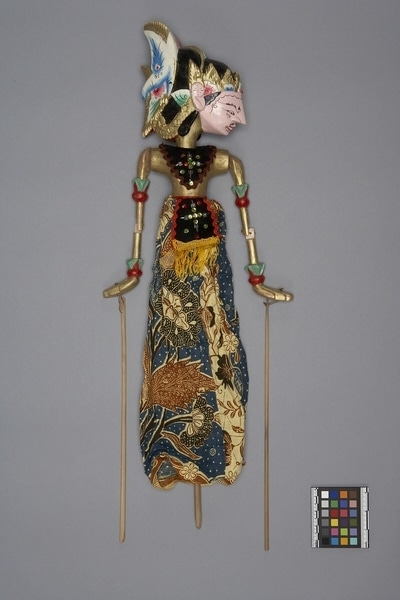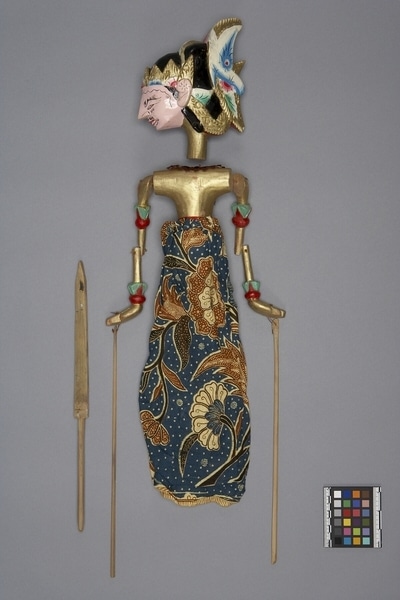Rod Puppet Item Number: Ib383 a-c from the MOA: University of British Columbia


Description
Three-dimensional male humanoid puppet: large head (part b) fits into body with skirt (part a), and a control rod (part c) with a long shaft that passes through the body and fits into the neck of the figure's head. The body has jointed arms, each with a long controlling rod attached. Pink face positioned downwards, with straight nose, red lips, white teeth. Hair, moustache, facial details and eyes outlined in black. Large headdress with gold diadem (jamang), black cap, and backwards facing blue, white and red Garuda Mungkur (long tongue) called sekar kluwih. Very small forward curl in front of Garuda (gelung keling?). Gold sumping, single kendit, green, red, blue decoration overall. Neck, upper body gold; arms with green and red ornaments at bicep and wrist. Black chest covering with wavy brown trim, sequins and beads in cross pattern on both chest covering and apron, which has a red waistband, red wavy trim and a long yellow fringe at bottom. Long batik skirt; beige with light brown, blue, and dark brown; seam at centre front.
History Of Use
Javanese puppetry as an art form probably developed by the 11th century. Wayang golek puppets of western Java appeared during the 16th century. Originally the plays depicted Javanese mythology, but after the Indian conquest of Java the Hindu epics, Ramayana and Mahabharata, were incorporated into the cycles, which comprise about 200 plays. A dalang (puppet master) performs the plays to celebrate important occasions, usually in three acts, with vocal and instrumental accompaniment. Typically they serve a moral and religious purpose, and more recently, one of political commentary. This puppet represents one of two Kurawa princes of the Mahabharata cycle (Jayawikata or Secamuka). It is likely that the same puppet is used for both, rather than having two separate puppets. They both serve the same roles in the plays from this cycle, which are largely concerned with the usurpation of the kingdom of the Pandawas by the Kurawa brothers. These two princes are allies of the antagonists, and would participate in the conflict.
Cultural Context
Theatrical performance.
Iconographic Meaning
Each puppet is characterized by its wanda, a Javanese word which describes the specific mixture of elements of size, form, colour, ornamentation and carving. Position and features of face are very refined, although pink face indicates aggressiveness or assertiveness. Batik skirt and Garuda suggest high rank. Gold skin colour reserved for nobility. Unusual headdress identifies puppet as Jayawikata or Secamuka, raden (princes) of the Mahabharata cycle.
Item History
- Made in Java, Indonesia
- Owned by Donald Bone before January 4, 1980
- Received from Donald Bone (Seller) and Museum of Anthropology Donations Fund (Funding source) on January 4, 1980
What
- Name
- Rod Puppet
- Identification Number
- Ib383 a-c
- Type of Item
- puppet
- Material
- wood, cotton fibre, fibre and paint
- Manufacturing Technique
- carved, painted, tied, woven and sewn
- Part A
- height 54.5 cm, width 23.0 cm, depth 7.0 cm
- Part B
- height 19.3 cm, width 8.0 cm, depth 16.0 cm
- Part C
- height 37.2 cm, width 2.2 cm, depth 1.5 cm
Who
- Culture
- Sundanese
- Previous Owner
- Donald Bone
- Received from
- Donald Bone (Seller) and Museum of Anthropology Donations Fund (Funding source)
Where
- Holding Institution
- MOA: University of British Columbia
- Made in
- Java, Indonesia
When
- Ownership Date
- before January 4, 1980
- Acquisition Date
- on January 4, 1980
Other
- Condition
- good
- Accession Number
- 0586/0002 a-c